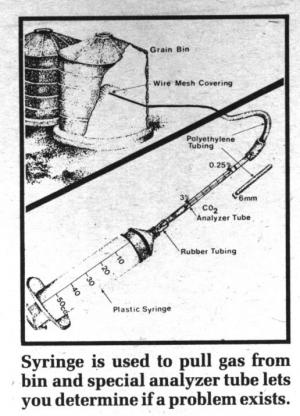Fast Simple Test Detects Grain Spoilage
 ✖  |
"It eliminates the need for temperature monitors and moisture testers for stored grain," says Ron Sinha who, along with researchers Bill Buir and Colin Demianyk, developed a testing kit that detects spoilage in grain by mold or insects much easier than conventional methods, completely preventing damage in most cases.
"Any biological process gives out CO2 so, if high concentrations of mold or insects are present, CO2 levels rise. Because this can be measured very precisely, we can now discover problem areas much earlier than ever before," says Sinha, who first began monitoring CO2 in grain bins in 1973 and discovered the link between spoilage and the gas in 1981. Since then he and his fellow researchers have been able to virtually eliminate spoilage in about 70 monitored bins. The scientists are just now preparing to "go public" with the idea at several scientific conferences and one company has expressed an interest in producing a commercial test kit, although all components can be purchased separately.
The kit consists simply of a piece of flexible Y4-in. dia. plastic tubing, a 50 milliliter plastic syringe and needle, two short pieces of rubber tubing 2 in. long and a CO2 analyzer cylinder roughly Y4-in. dia. by 5-in. long.
The plastic tubing is shoved down into the grain. The end is covered by wire mesh to keep grain out and a rubber stopper placed in the other end. The syringe needle is pushed through the rubber stopper just like sticking a needle into a drug bottle. One short rubber tube connects the top end of the syringe to the CO2 analyzer and the second rubber tube connects the bottom of the CO2 analyzer to the bottom of the plastic syringe.
"The analyzer cylinder contains a material that changes color, depending on the amount of CO2 gas present. You can tell precisely the percentage of CO2 present by how far down the color extends down the tube," says Sinha.
For best results, Sinha recommends testing at several spots in the bin. Tubes can be installed permanently by drilling holes in bin walls when the bin is empty or you can simply attach a tube to a long pole and shove it down into the grain.
Sinha says that under normal, stable conditions CO2 levels in grain range from 0.03% to 0.04% Grain that tests from 0.08% to 0.1% may have low level spoilage just beginning and no hot spots can be detected. However, as CO2 levels increase up to 1%, steps should be taken to stop the spoilage or damage will occurr.
Sinha says the CO2 test kit is being evaluated by researchers throughout Canada and the U.S.
For more information, contact: FARM SHOW Followup, Ron Sinha, Ag Canada, 195 Defoe Road, Winnepeg, Canada R3T 2M9 (ph 204 269-2100).

Click here to download page story appeared in.
Click here to read entire issue
Fast Simple Test Detects Grain Spoilage CROP STORAGE Grain Storage 9-5-7 "It eliminates the need for temperature monitors and moisture testers for stored grain," says Ron Sinha who, along with researchers Bill Buir and Colin Demianyk, developed a testing kit that detects spoilage in grain by mold or insects much easier than conventional methods, completely preventing damage in most cases.
"Any biological process gives out CO2 so, if high concentrations of mold or insects are present, CO2 levels rise. Because this can be measured very precisely, we can now discover problem areas much earlier than ever before," says Sinha, who first began monitoring CO2 in grain bins in 1973 and discovered the link between spoilage and the gas in 1981. Since then he and his fellow researchers have been able to virtually eliminate spoilage in about 70 monitored bins. The scientists are just now preparing to "go public" with the idea at several scientific conferences and one company has expressed an interest in producing a commercial test kit, although all components can be purchased separately.
The kit consists simply of a piece of flexible Y4-in. dia. plastic tubing, a 50 milliliter plastic syringe and needle, two short pieces of rubber tubing 2 in. long and a CO2 analyzer cylinder roughly Y4-in. dia. by 5-in. long.
The plastic tubing is shoved down into the grain. The end is covered by wire mesh to keep grain out and a rubber stopper placed in the other end. The syringe needle is pushed through the rubber stopper just like sticking a needle into a drug bottle. One short rubber tube connects the top end of the syringe to the CO2 analyzer and the second rubber tube connects the bottom of the CO2 analyzer to the bottom of the plastic syringe.
"The analyzer cylinder contains a material that changes color, depending on the amount of CO2 gas present. You can tell precisely the percentage of CO2 present by how far down the color extends down the tube," says Sinha.
For best results, Sinha recommends testing at several spots in the bin. Tubes can be installed permanently by drilling holes in bin walls when the bin is empty or you can simply attach a tube to a long pole and shove it down into the grain.
Sinha says that under normal, stable conditions CO2 levels in grain range from 0.03% to 0.04% Grain that tests from 0.08% to 0.1% may have low level spoilage just beginning and no hot spots can be detected. However, as CO2 levels increase up to 1%, steps should be taken to stop the spoilage or damage will occurr.
Sinha says the CO2 test kit is being evaluated by researchers throughout Canada and the U.S.
For more information, contact: FARM SHOW Followup, Ron Sinha, Ag Canada, 195 Defoe Road, Winnepeg, Canada R3T 2M9 (ph 204 269-2100).
To read the rest of this story, download this issue below or click
here to register with your account number.







